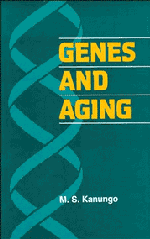6 - Theories of aging
Published online by Cambridge University Press: 22 March 2010
Summary
All multicellular organisms have two striking characteristics: (1) they show a gradual decline in their adaptability to the normal environment after attaining reproductive maturity, and (2) all members of a species have a more or less fixed life span. These two characteristics are inherited, and hence genetically controlled. Rats, mice, and Drosophila, kept under controlled environmental conditions, live for periods characteristic of the species and strain.
Besides these characteristics, it is also known that the time required for all members of a species to reach reproductive maturity is the same, as for example, 10 weeks for rats and 12 years for humans. Likewise, the reproductive period of all individuals of a species is more or less the same. The various stages of development leading to reproductive maturity are precisely timed. Thus, it is likely that developmental changes up to the attainment of reproductive maturity are genetically controlled and occur according to a genetic program.
Medvedev (1990) has brought together all theories on aging, classified them, and made an analysis of each group of theories. We shall consider here only those theories that attempt to explain aging at the genetic level. These theories are based on genes as the primary sites at which changes occur to initiate the process of aging. Factors such as food, temperature, humidity, radiation, pollution, and various stresses, however, influence the rate of aging.
Before discussing these theories, certain characteristics of aging that point to genetic involvement need to be considered.
- Type
- Chapter
- Information
- Genes and Aging , pp. 246 - 282Publisher: Cambridge University PressPrint publication year: 1994



